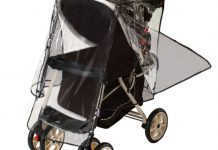10 Best Prenatal Monitors Reviewed in 2024
For expectant mothers, finding a way to interact and connect with your child before they are born is oftentimes very important. Not just from a bonding standpoint, but also from a safety standpoint, mothers like having the option to monitor how their little one is doing. The easiest way to do that? A prenatal monitor! These monitors typically help you track and listen your baby’s heartbeat. Instead of having to wait until going to your next doctor’s appointment, you can listen right from the comfort of your own home! If you aren’t sure about the benefits of a prenatal monitor or don’t know which is right for you, you’ve come to the right place. We have selected the ten best prenatal monitors and also have plenty of other information to help you make the right decision.
In a Hurry? The test winner after 58 hrs of research

No hazardous wires or cords
Easily portable
Lightweight
Intuitive and alerts you when something might be wrong

10 Best Prenatal Monitors
1. Snuza Hero
No hazardous wires or cords
Easily portable
Lightweight
Intuitive and alerts you when something might be wrong
Meant to help monitor baby after they’re born
False alarms do happen frequently
The Snuza Hero is handy because it’s wearable and has no wires, cords, or sensor pads. A vibration alert will go off after 15 seconds of no movement in your baby’s abdomen and a sharp alarm is triggered by 20 seconds of inactivity after three rounds of unresponsive vibration alerts.
Read moreDesign
This portable device allows you to monitor your child’s abdominal movement. You can clip it easily to their diapers!
Effectiveness
The Snuza Hero doesn’t just monitor your child’s activity--it also helps to stimulate it. If 15 seconds of inactivity passes, the device will vibrate gently to try to rouse your baby.
Ease of Use
Clip it onto your belt or a baby diaper to keep track of it and allow it to easily follow you without you having to pick it up and put it down a hundred times throughout the day.
Value
This is probably the biggest investment on the list. It does more than just allowing you to listen to your little one, though. It also tracks their movement and tries to keep them healthy and in motion.
2. Jumper Angel Sounds
Can clearly hear your child’s heartbeat
Two ports so partners can listen together
Option to record and playback your own heartbeat or baby’s (with the right cable/tools)
Small and easily transportable
Not many additional features
One customer received a faulty unit that stopped working after a week
Angel Sounds by Jumper allows you to listen to your baby’s heartbeat right at home. From twelve weeks onward, you’ll be able to plug in and listen to that steady little thrum. Trips to the doctor can bring you closer to Baby but they also require some serious planning, time commitment, and travel. Now you can fall asleep listening to that little heartbeat in your own bed.
Read moreDesign
This is a pocket-sized fetal Doppler. It’s easily transportable and fits inside bags and pockets. There’s no clip on it, which is a bummer, but you could probably find a way to fashion one if that’s the most convenient way for you to attach this to your person.
Effectiveness
This device does more than just amplifying your little one’s heartbeat. You can also record it as well as being able to record your own heartbeat and play it back for your baby. The sound is comforting to mother and child.
Ease of Use
There aren’t many buttons or fancy features on this so it’s pretty straightforward how to use it. It also comes with a user’s manual in case you get stuck.
Value
This is a pretty low price point when it comes to prenatal monitoring and listening devices. It’s not high tech but it gets the job done and at a truly reasonable value!
3. Kicktrak
Simple and easy to use - just press the button when you feel the baby kick!
The song is helpful so you know when you can stop and feel confident baby is doing okay
Carrying strap makes it easy to take with you wherever you go
Very affordable
You have to track the kicks yourself
Does not track heartbeat
While different from typical prenatal monitors, this amazing Kicktrack system is still beneficial for parents and can help you detect if something is wrong with your child.
Read moreThis kick and movement monitoring system is truly a genuine and effortless way to observe the movement of your little one before you have a pleasure to meet him/her in person!
Design
It contains a carrying strap, push button for each time you feel a movement and comes with 90-day limited warranty. Helps you count kicks and movements and plays a song when your session is complete and tenth movement is tracked.
Effectiveness
This monitor from Kicktrak is a bit different from other monitors on this list. When you start a session, you are looking to feel ten separate movements. This particular model does not track heartbeat but instead tracks your baby’s kicks.
Easy of Use
Once you’ve logged all ten movements, music plays to alert you your session is complete! This makes it easier on you so you can just focus on noticing your baby kicking, rather than having to count and keep track in your head.
Value
This is an incredibly affordable monitor and is a great value for the money. While it does have fewer features, it is also significantly less money, so it is a great option for any parent wanting to monitor their child’s movements and kicking.
4. WavHello Belly Buds
Easy setup
Plays your favorite music for baby
Comes with adhesive backings
Can control their volume separately from yours
Doesn’t monitor baby’s movement
Sound quality isn’t great
Babies in the womb can hear around 20 weeks and start forming memory at 30 weeks. These BellyBuds will help enhance your little one’s afternoon by playing them all your favorite music! They’re portable, discreet, and a great way to bond with the baby.
Read moreDesign
The BellyBuds plug right into your MP3 player or phone and adhere to your stomach via safe, reusable adhesives. You can even control volume specifically going through to them with a little dimmer switch.
Effectiveness
These headphones let your little one hear all of your favorite tunes right alongside you. Music is a great stimulant with lots of mental and physical benefits to gleam. Start your little bean early!
Ease of Use
All you need to do is plug the auxiliary cord end of these into whatever device you’re using to listen. From there, you can separately control Baby’s volume, and choose which songs to listen to and which to skip.
Value
This is a middle-of-the-road price point for our guide and we think, given the quality of the product, it’s fairly valued.
5. Bellytunes Earbuds
Allows you to play music for your child
Adheres easily to the stomach and actually works
Compact, easy to travel with
Noninvasive and totally safe
Doesn’t monitor baby; plays music for them in the womb
Want to listen with your baby instead of syncing to another week’s worth of podcasts all alone? The Bellytunes Earbuds allow you to wear your normal listening device and still bump up the baby tunes.
Read moreDesign
They’re super compact, they’re easy to use, and they’re noninvasive. Simply slip your existing earbuds into the structure and secure it gently to your stomach.
Effectiveness
This system transforms your iPod and Android earbuds into baby bump speakers.
Ease of Use
These don’t require much setup or much technological know-how. They attach easily and disassemble just as quickly.
Value
These are one of the less expensive options on our list. They’re meant for playback for your baby rather than monitoring, but playing soothing music and creating a warm environment is a quick way to destress your little baby-to-be.
Criteria Used for Evaluation

Design
User ratings are always important, and we especially took them into consideration when selecting prenatal monitors. Pregnancy can be a scary time, and the last thing a pregnant mother wants is a bad prenatal monitor that scares her into thinking something is wrong with her baby. Instead, we select monitors that parents enjoy using and have had success with.

Effectiveness
It is always important to consider the manufacturer’s reputation when selecting items you will use with your child. We prefer to select items that have a solid reputation in the baby industry as being effective, easy to use, and most importantly, safe. Prenatal monitors are no different, and we only selected monitors that are safe for you to use during your pregnancy (always use as directed).

Ease of Use
Let's be real, it is important to select items that are easy to use. The same goes for prenatal monitors. If it is incredibly difficult to find your child’s heartbeat, that can be very stressful. Instead, we selected monitors that parents found to be easy to use. Keep in mind, you should wait until the 16-week mark, but that will be the case for any monitor you select. After that point, all of these monitors should work great and you should easily be able to find a heartbeat.

Value
Price is always a determining factor when making our decisions. This is especially true with non-necessary items such as a prenatal monitor. You do not need this item (unlike car seats, cribs, bottles, baby monitors, etc.) so the price is important when making the decision if you want to purchase it or not. It is a tech item so there will be a substantial cost involved, but we still look to find affordable options so that most parents can afford it should they want to use it.
The only danger with these products arises when a mother starts to experience signs that may mean that her baby is distressed. Often times, one of the most common of these possible signs of distress in an unborn baby is decreased fetal movement. A mother might experience this and then decide to check on her baby’s heartbeat using an at-home prenatal monitor. It’s perfectly likely that she could find her baby’s heartbeat no problem and then assume that everything is okay and not seek any help.
Other Factors to Consider

Safety
Generally, these devices are considered to be safe for you and your little one, but there is some debate about if they are actually safe to be used by non-professionals at home. Even though there can be these possible problems with a prenatal monitor used at home in a non-professional setting, there is nothing wrong with getting one and using it as long as you know what to expect and that you should not allow yourself to have these strong reactions to the prenatal monitor. Understand that as a non-professional, you may not always be able to find your little one’s heartbeat, but that does not mean that something is wrong.
It likely just means that your little one is in a difficult or different position. If you aren’t having any other signs of any problems, don’t worry too much about it and just try again at another time or on another day. Similarly, if you are having problems of some kind, such as noticing a drop in prenatal movement, you should seek help immediately. Go to your pregnancy health care provider. Don’t even bother checking your baby’s heartbeat yourself if there is a potentially serious problem. Even if you do find the heartbeat, it doesn’t mean that everything is okay. Going to your health care provider is the best way to determine that. Overall, the thing you need to remember with these monitors is that they are for fun and are not to be used for real medical purposes in a non-professional environment.

Side Effects
The possible problems that may be run into when it comes to using these at-home prenatal monitors have nothing to do with the device itself, as the monitors are completely safe. Instead, the problems arise due to the users being non-professionals and not knowing exactly how to use the devices. This can cause problems in a couple of different ways. Since you are not a trained professional, it may not be as easy for you to find your baby’s heartbeat. If you struggle to find your baby’s heartbeat, you may, understandably, panic that something is wrong with your baby.
This will likely cause you to go see your pregnancy health care provider and make sure that everything is okay with your little one and chances are that everything is fine because there are many reasons that you may struggle to find your baby’s heartbeat using the at-home prenatal monitor. Many mothers may buy this type of product in order to give themselves reassurance that everything is okay with their precious little one, but unfortunately, it can often cause the opposite effect. After all, if you are searching for your baby’s heartbeat and can’t seem to find it, it makes complete sense that you would be scared and may even panic thinking that something might be wrong with your baby.
Interesting enough, a much more dangerous effect that these prenatal monitors may have is actually the opposite of the first problem that they may cause. Using an at-home prenatal monitor can actually give you false reassurance that everything is okay with your baby even when it actually may not be okay at all. Many mothers feel as if they can hear their baby’s heartbeat that everything else must be just fine with their baby as well. Unfortunately, this is not the case at all.
Frequently Asked Questions
q: Are prenatal monitors safe?
Yes. It is safe for you to use a prenatal monitor during your pregnancy. These monitors use the same technology that ultrasound devices at a doctor’s office use. With low levels of power and safe ultrasound waves, these devices are safe and will not harm your baby. However, it is dangerous if you choose to use an at-home device instead of going to a doctor. Never use an at home monitor in place of visiting a doctor. Should you notice something off when using your monitor at home, immediately schedule an appointment with your OB/GYN.
q: When can I use a prenatal monitor?
Prenatal monitors work best once a baby has developed a strong enough heartbeat that you will be able to detect. In perfect conditions, you can start to hear a heartbeat at around 8 weeks. However, it is difficult at this stage to hear a heartbeat, which can be alarming to expectant mothers. This is not a sign that something is wrong, you are just too early in your pregnancy. It is best to wait until 16 weeks to start trying to find a heartbeat. By this point, your baby’s heartbeat will be much stronger and you will have a much easier time detecting it. Should you try while between 8 and 16 weeks pregnant, do not be alarmed if you don’t find one. Also, be sure to use a good ultrasound gel to help reduce static. This will make it even easier for you to detect and hear the heartbeat.
q: How does a prenatal monitor work?
The main type of prenatal monitor is a doppler monitor. These monitors work via the Doppler effect. The probe of your monitor will send out an ultrasound wavelength and reflect or “bounce” off of your baby’s heart. The device monitors the change in frequency and wavelength in order to determine the heartbeat rate. The waves are translated into sound, which is what you hear and recognize as a heartbeat. The number is also calculated and displayed if you have a monitor that includes a screen.
Sources
- , Doppler Tips: Using your Baby Heartbeat Monitor, Online Article
- , How to Listen to Your Baby's Heartbeat, Online Article
- , Fetal Heart Rate Monitoring: What to Expect, Online Article

































